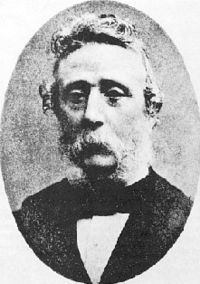Richard Leach Maddox
| Richard Leach Maddox | |
|---|---|

Richard Leach Maddox
|
|
| Born |
4 August 1816 Bath, England |
| Died | 11 May 1902 (aged 85) Portswood, Southampton, Hampshire, England |
| Residence | England |
| Citizenship | British |
| Nationality | British |
| Fields | Photographer Physician |
| Notable awards |
John Scott Medal (1889) Royal Photographic Society's Silver Progress Medal (1901) |
| Spouse | Amelia Maddox (1849-1871) Agnes Maddox (1875-1902) |
Richard Leach Maddox (4 August 1816 – 11 May 1902) was an English photographer and physician who invented lightweight gelatin negative plates for photography in 1871.
Richard Leach Maddox was born at Bath, England, on 4 August 1816.
Long before his discovery of the dry gelatin photographic emulsion, Maddox was prominent in what was called photomicrography - photographing minute organisms under the microscope. The eminent photomicrographer of the day, Lionel S. Beale, included as a frontispiece images made by Maddox in his manual 'How to work with the Microscope'
Maddox freely gave his discovery to the world, saying (to W. J. Harrison, in a letter of 1887) that "[I had] no thought of bringing the subject into notice until it had been lifted from the cradle". Maddox, at the initial stage of invention, could probably produce only 'lantern slides' contact-copied from his microscope plates, the slow speed being impracticable for camera lens images.
It was these origins that led to the miniaturization and adaptability of photographic emulsions, and consequently paved the way for social and action photography and cinematography.
In photography, the Collodion process was invented in 1851 by Frederick Scott Archer. This invention required only two to three seconds of light exposure to produce an image, but plates had to be sensitized at the time of exposure, exposed while the emulsion was still wet, and processed immediately after exposure in the camera.
When he noticed that his health was being affected by the 'wet' collodion's ether vapor, Maddox began looking for a substitute. He suggested in the 8 September 1871 British Journal of Photography article An Experiment with Gelatino-Bromide that sensitizing chemicals cadmium bromide and silver nitrate should be coated on a glass plate in gelatin, a transparent substance used for making candies. Eventually Charles Harper Bennett made the first gelatin dry plates for sale; before long the emulsion could be coated on celluloid roll film.
...
Wikipedia
